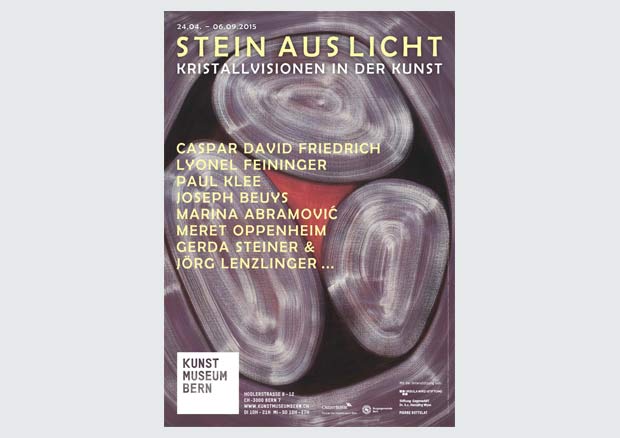Stone of Light. Crystal Visions in Art, 24.04. - 06.09.15
Crystal as Font of Inspiration
With the exhibition Stone of Light: Crystal Visions in Art, the Kunstmuseum Bern is thematically focusing on how crystal and its specific, intrinsic qualities fascinate artists. Seen through the multi-faceted lens of crystal, we are taking a closer look at art from romanticism through to the present. We are showing paintings and drawings by artists such as Caspar David Friedrich, Bruno Taut, Lyonel Feininger, Paul Klee, and Meret Oppenheim; photographs by Alfred Ehrhardt; and installations by Josef Beuys, Marina Abramović, and Gerda Steiner & Jörg Lenzlinger—artists who were all inspired by crystal as ideal form or symbol.
To our way of thinking, crystal exemplifies an ideal structure that at the same time has something enigmatic about it, a miraculous creation of alchemy. Since romanticism at latest, crystal has been pivotal in inspiring artists—either because of its regular structure influencing design in art or as a symbol. Crystal rock is something rare, valuable, and difficult to mine. Although a material thing of hard, cold stone, crystal radiates a light that does not seem of this world. Crystal as a mythological conception is associated with the promise of clarity and transformation, which, like art, touches our emotions.
A Tour of the History of Art
Mounting some 100 works of art, the exhibition engages with the subject as viewed from 5 different facets. Facet 1 shows exhibits staging crystal as a symbol of love, power, and death. In Facet 2, we are presenting paintings that illustrate the crystalline nature of mountains, revealing alpine landscapes in their breathtaking sublimity. You will find works of the romantic period here by masters such as Caspar David Friedrich, Caspar Wolf, and Alexandre Calame. In his painting Le grand Eiger, the latter painter created a monument to Eiger Mountain, turning it into a gigantic crystal that is lit up by the sun from behind. Facet 3 reveals how crystalline forms have continued to inspire artists and architects throughout the modern period into the present. You can view Bruno Taut’s drawings of his futuristic, architectural visions. We have also mounted a model of Monte Rosa Hut in the Canton of Valais. The building was inaugurated in 2009 and its structure is reminiscent of crystal. In Facet 4, we have arranged a group of works by artists such as Lyonel Feininger, Paul Klee, Fritz Winter, and Georges Braque. The works of the artists represented in this section show how they have interpreted crystalline qualities as a structural principle in painting, paving the way to abstraction and facilitating the dismissal of outdated notions about realistic art, striving toward profundity in regard to the nature of things in general. Additionally in this section, we are presenting Adolf Hölzel’s crystalline paintings. This artist was constantly in search of the laws of harmony in regard to color and form. Facet 5, as the final section, is devoted to contemporary art. Joseph Beuys understood crystal as symbolizing the cold pole of analytical thought, whereas Meret Oppenheim discovered its magical sides. And Marina Abramović’s work, Shoes for Departure, made of amethyst, stands for inner awakening. Finally, the artist duo Gerda Steiner & Jörg Lenzlinger let real crystals grow in the exhibition.
Crystalline Form in the Architecture of the Exhibition
Ulrich Zickler is the architect behind the design of the exhibition. The crystalline form of the imagery in the works of art is mirrored in the architecture of the show, which stands out on account of its clear-cut changes in direction and three-dimensional wall elements. It seeks to submerge our visitors in the atmospheric world of crystal. With Stone of Light: Crystal Visions in Art, the Kunstmuseum is continuing its tradition of themed exhibitions like Six Feet Under, Lust and Vice, or The Weak Sex.
Contact person: Brigit Bucher, , Tel.: +41 31 328 09 21
Images: Marie Louise Suter, , Tel.: +41 31 328 09 53
Works by: Marina Abramović, Johann Jakob Biedermann, Georges Braque, Joseph Beuys, Alexandre Calame, Carl Gustav Carus, Alfred Ehrhardt, Lyonel Feininger, Caspar David Friedrich, Bernard Frize, Augusto Giacometti, Max Gubler, Wenzel Hablik, Adolf Hölzel, Paul Klee, Franz Niklaus König, Richard Paul Lohse, Franz Marc, Michail Matjuschin, Gabriel Loppé, Gabriel Lory, Meret Oppenheim, Thomas Ruff, Hans Scharoun, Yutaka Sone, Gerda Steiner & Jörg Lenzlinger, Bruno Taut, Fritz Winter, Caspar Wolf, Robert Zandvliet


